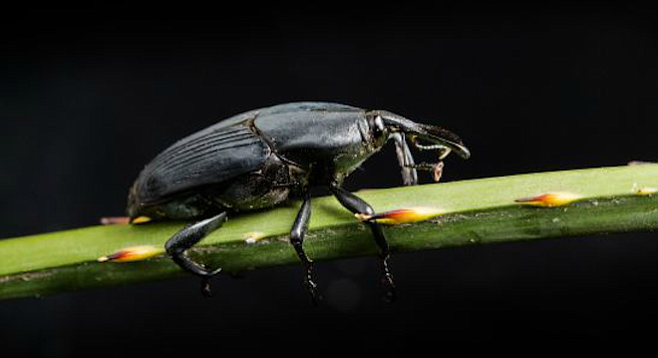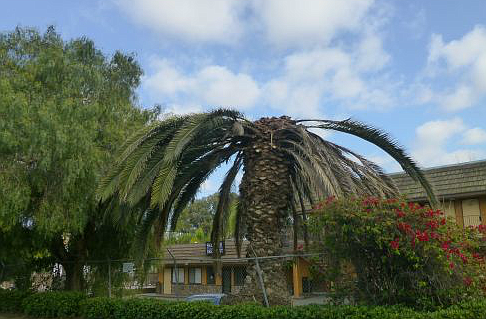 Facebook
Facebook
 X
X
 Instagram
Instagram
 TikTok
TikTok
 Youtube
Youtube

San Ysidro, Chula Vista, and now Bonita residents are watching their Canary Island palms choke and die — sometimes with the entire crown falling to the ground below. The culprit? The South American palm weevil (Rhynchophorus palmarum) on its first forays into Southern California.
"They lay eggs in the crown and the grubs destroy the tissue in the palm heart and destroy the tissue that holds the fronds, so the first sign of infestation is seeing the crown droop and turn brown," says Mark Hoddle, an entomologist with the University of California Riverside who is considered the state expert on the big bug.

"The tree can't grow any new fronds and all you are left with is a halo of dying fronds."
Hoddle said that by making palms a part of the Southern California landscape, humans have created a potentially enormous area for the pests to infest.
"In California, palms define the urban landscape, and the insects travel from one human-made palm oasis to the next," he said. "I hate to think what could happen if they reach the palm oases in the Anza-Borrego Desert."
For now, they're eating the tastiest palms, feasting mainly on Canary Island palms, but they've been known to lay eggs in and kill other types of palms as well. California's ornamental palms and date palms is where they'll lay eggs once the feast of Canary Island palms ends.
"They've killed many palms in Bonita and the Sweetwater Regional Park, and now they're killing trees in the Glen Abbey Cemetery,” Hoddle said. "Just think of the Hotel del Coronado and the many places that have planted palms, and how vulnerable they are to an insect with tremendous ability to fly distances."
The adult bugs are big — between an inch or two in length — and they're loud. "You can hear them flying in from quite far away," Hoddle said. "They're black with red markings."

Hoddle first heard of the bugs' arrival in North America from a colleague in Tijuana who saw palms dying in this odd fashion. Now, Hoddle and his wife drive to San Diego most weekends to see how far the bugs have spread. They've easily captured the bugs using a bucket full of pheromone-tainted overripe fruit, he said.
"We've tested their flying capacity and our data suggests it can fly quite far, tens of miles in a day," Hoddle said. "Its potential territory in California and the Southwest is enormous."
The bugs have hopscotched their way from one human-created oasis to another, and there's no end in sight, Hoddle said.
There's also no funding to study the bugs and protecting the trees comes down to persistent treatment with pesticides that has to become serial, regular treatment to work, he said.
"There are palm trees in the Mediterranean with PVC pipes up the side and a shower head at the top where a pump blasts pesticides every few months," he said. "There are also systemic pesticides you can put in the tree roots. Both of these methods have to be repeated at regular intervals to succeed."
The bug is known to carry a deadly bonus: red ring nematodes, which are sure and determined killers of palms.
"We haven't found the nematode so far, but there aren't many people looking," he said.
Meanwhile, Hoddle and wife continue to drive the county looking for the weevils, which seem likely to spread throughout California.
"I went to Sweetwater after the storms rolled through two weeks ago and there were many fallen crowns," Hoddle said. "The crowns weigh a couple of hundred pounds and if they fall on something like a car or house, they can do considerable damage."


San Ysidro, Chula Vista, and now Bonita residents are watching their Canary Island palms choke and die — sometimes with the entire crown falling to the ground below. The culprit? The South American palm weevil (Rhynchophorus palmarum) on its first forays into Southern California.
"They lay eggs in the crown and the grubs destroy the tissue in the palm heart and destroy the tissue that holds the fronds, so the first sign of infestation is seeing the crown droop and turn brown," says Mark Hoddle, an entomologist with the University of California Riverside who is considered the state expert on the big bug.

"The tree can't grow any new fronds and all you are left with is a halo of dying fronds."
Hoddle said that by making palms a part of the Southern California landscape, humans have created a potentially enormous area for the pests to infest.
"In California, palms define the urban landscape, and the insects travel from one human-made palm oasis to the next," he said. "I hate to think what could happen if they reach the palm oases in the Anza-Borrego Desert."
For now, they're eating the tastiest palms, feasting mainly on Canary Island palms, but they've been known to lay eggs in and kill other types of palms as well. California's ornamental palms and date palms is where they'll lay eggs once the feast of Canary Island palms ends.
"They've killed many palms in Bonita and the Sweetwater Regional Park, and now they're killing trees in the Glen Abbey Cemetery,” Hoddle said. "Just think of the Hotel del Coronado and the many places that have planted palms, and how vulnerable they are to an insect with tremendous ability to fly distances."
The adult bugs are big — between an inch or two in length — and they're loud. "You can hear them flying in from quite far away," Hoddle said. "They're black with red markings."

Hoddle first heard of the bugs' arrival in North America from a colleague in Tijuana who saw palms dying in this odd fashion. Now, Hoddle and his wife drive to San Diego most weekends to see how far the bugs have spread. They've easily captured the bugs using a bucket full of pheromone-tainted overripe fruit, he said.
"We've tested their flying capacity and our data suggests it can fly quite far, tens of miles in a day," Hoddle said. "Its potential territory in California and the Southwest is enormous."
The bugs have hopscotched their way from one human-created oasis to another, and there's no end in sight, Hoddle said.
There's also no funding to study the bugs and protecting the trees comes down to persistent treatment with pesticides that has to become serial, regular treatment to work, he said.
"There are palm trees in the Mediterranean with PVC pipes up the side and a shower head at the top where a pump blasts pesticides every few months," he said. "There are also systemic pesticides you can put in the tree roots. Both of these methods have to be repeated at regular intervals to succeed."
The bug is known to carry a deadly bonus: red ring nematodes, which are sure and determined killers of palms.
"We haven't found the nematode so far, but there aren't many people looking," he said.
Meanwhile, Hoddle and wife continue to drive the county looking for the weevils, which seem likely to spread throughout California.
"I went to Sweetwater after the storms rolled through two weeks ago and there were many fallen crowns," Hoddle said. "The crowns weigh a couple of hundred pounds and if they fall on something like a car or house, they can do considerable damage."
Comments